It’s a simple number—two digits, almost too common to notice, but somewhere in the annals of pop culture, 42 became something far greater than the sum of its parts. If you’ve ever dabbled in sci-fi, or hung out with anyone who has, you’ve probably heard of the number 42 as “the answer to the ultimate question of life, the universe, and everything.” But how did such an ordinary number come to carry such extraordinary weight?
The Birth of 42: A Quick Dive into the Hitchhiker’s Guide
Douglas Adams, a British writer with a penchant for blending the absurd with the profound, introduced 42 to the world in his 1979 novel, The Hitchhiker’s Guide to the Galaxy. The story follows Arthur Dent, an ordinary human, who is whisked away on an intergalactic adventure just as Earth is destroyed to make way for a hyperspace bypass. In this universe, where nothing seems to make much sense, a group of hyper-intelligent beings builds a supercomputer named Deep Thought to calculate “the Answer to the Ultimate Question of Life, the Universe, and Everything.”
After seven and a half million years of computation, Deep Thought finally reveals the answer: 42.
Why 42?
That’s the million-dollar question, isn’t it? Why did Adams choose 42? Well, the truth is, he didn’t have some grand, hidden meaning behind the number. According to Adams himself, 42 was chosen simply because it was “a funny number.” In an interview, he explained that he sat at his desk, thinking up a random, ordinary number, and settled on 42.
But, in true internet rabbit hole fashion, fans of Adams and The Hitchhiker’s Guide refused to accept that explanation at face value. Surely, they reasoned, a writer as clever and witty as Adams must have hidden some deeper significance in the number. Over the years, this simple, offhand choice has sparked countless theories and debates.
The Many Theories of 42
-
Mathematical Curiosities: Mathematicians have had a field day with 42. It’s a pronic number (the product of two consecutive integers, in this case, 6 and 7), a Harshad number (an integer divisible by the sum of its digits), and even pops up in the field of string theory. Some fans have suggested that Adams might have been subtly referencing these mathematical properties. But Adams was a self-professed “word person,” not a math genius, so this seems more like a case of coincidence rather than intentional design.
-
Binary Connections: In binary code, 42 is represented as 101010. This pattern has intrigued computer geeks and conspiracy theorists alike, who suggest that Adams, known for his love of technology, might have chosen 42 as a nod to the digital world. However, like the mathematical theories, there’s no hard evidence to support this.
-
Philosophical Musings: Some fans have gone deep into philosophical interpretations. In these circles, 42 is seen as a metaphor for the absurdity of trying to find meaning in a chaotic universe. This ties back to the broader themes of The Hitchhiker’s Guide, where the search for meaning often leads to nonsensical or disappointing answers.
-
Historical References: A particularly esoteric theory suggests that 42 refers to the number of lines on each page of the Gutenberg Bible, the first major book printed using movable type. While this is an interesting fact, there’s no evidence Adams was referencing this historical tidbit.
The Cultural Legacy of 42
Regardless of Adams’ intentions, 42 has taken on a life of its own. It’s become a part of geek culture, a shorthand for the absurd, the unknowable, and the cosmic joke of existence. In the decades since The Hitchhiker’s Guide was published, 42 has been referenced in everything from video games to movies, and even in real-world science.
For instance, in 2019, researchers at the University of Tokyo used the number 42 in an experiment to solve a complex mathematical problem involving the sum of three cubes. Coincidence? Maybe. But it’s another layer to the ever-growing mythology surrounding this simple number.
The Internet’s Obsession
The internet, with its boundless curiosity and love of inside jokes, has ensured that 42 remains firmly embedded in pop culture. On forums, social media, and even in the comments sections of completely unrelated content, you’ll find people dropping references to 42, often with a wink and a nod to fellow fans.
This collective fascination has kept The Hitchhiker’s Guide to the Galaxy relevant decades after its publication, as each new generation discovers the series and inevitably stumbles upon the enigma of 42. It’s a prime example of how a small, seemingly insignificant detail can snowball into something much bigger, driven by the collective imagination and humor of fans around the world.
Adams’ Last Laugh
Douglas Adams passed away in 2001, but his creation lives on, not just in his books but in the ongoing cultural impact of 42. It’s a testament to Adams’ unique blend of humor and insight, his ability to make us laugh while also making us think. 42 may not have a deeper meaning, but in a way, that’s the whole point. The absurdity of assigning meaning to randomness, of searching for answers in an indifferent universe—these are themes that resonate more than ever in our modern world.
So, the next time you hear someone mention 42, you’ll know there’s no grand secret behind it—just a bit of brilliant absurdity from a writer who knew how to make us all smile at the strange and wonderful complexity of life.

